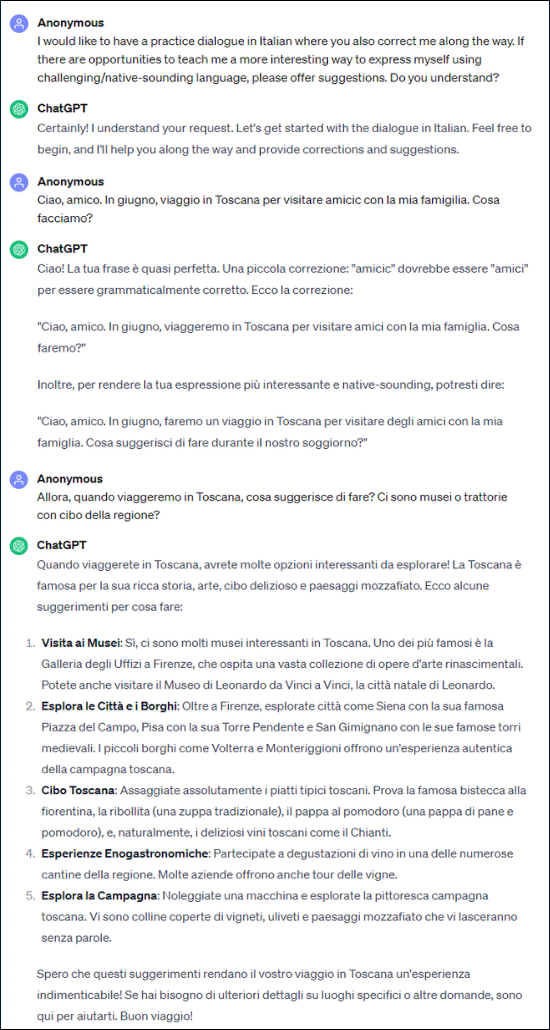AI as a collaborative partner in language learning: Part 2
 This was a really fun experiment for me because as a former teacher, my initial gut reaction was to seek out standards and work backward building a lesson plan and thinking of assessment points that I would want to hit along the way. Old habits die hard!
This was a really fun experiment for me because as a former teacher, my initial gut reaction was to seek out standards and work backward building a lesson plan and thinking of assessment points that I would want to hit along the way. Old habits die hard!
But what I found is that this is not how I as a learner (and probably most other learners!) would want to approach this subject.
I found that things really started to take shape for me when I put on my student hat and just hopped onto the platforms. I started interacting with it like I imagined a student would – asking questions and giving soft parameters based on my knowledge of the subjects I was asking about. I started to understand how to work with it by trial and error.
If you work with any students who are of the video game-loving age range, you may already know how much of their experience with games, social media platforms, and any new tech is, more often than not, through trial and error and observing how others are using the tools.
I mean, how many times have you seen a younger person go to the instruction manual of a video game before just jumping in and trying to play the game? Or what about TikTok or any other social media platform? Chances are they jumped into the platform first and learned by seeing, hearing, and experiencing the content there and then replicating it or doing something similar in their own context. Sometimes that is just the best way to learn something – by throwing yourself into the deep end and just going for it!
Parameters, Pedagogy, and Personalized Learning
Now I know many educators might think that is terrifying when we are talking about AI, especially in a classroom context and I get it. It’s crucial to consider all the parameters that you need to put in place to do this safely and according to any protocols put forth by your district or school.
The ultimate goal is to get students to experience AI in an authentic way – not being too prescriptive is certainly one way to do it. Another option is to give students a plethora of prompts for them to use as a starting point but then ultimately give them the keys to the car and see what they come up with.
With language learning, it can be tough to find these authentic experiences with speakers of the language. We might have recordings of mother-tongue speakers, but that leaves no room for interaction. We have texts in the target language, but how can we write back, or respond to what we are reading?
This is where AI-empowered platforms can allow us to simulate real-life applications.
We do not learn language in a vacuum. We learn language through context and AI can help create that for us as learners when we are unable to be in the countries where the language we are learning is spoken. As immersive of an experience as we can create the better – that is where the contextual building blocks come together.
Get to the Good Stuff
I put on my student hat and turned to AI—jumping onto two platforms: my old friend ChatGPT and my new acquaintance HyperGlot as provided by Character AI (go to “Practice a new language”).
When I started a conversation with ChatGPT about a trip to Italy, I established some parameters that were very much like that of a teacher’s assignment directions. But then, I started to expand upon that in a way that made sense to me as a learner – letting my curiosity serve as the guide. This allowed me to find content that was genuinely of interest to me and also refine my prompts in a way that allowed me to do some discovery on my own.

HyperGlot was brand new to me so I was tentative in my approach at first. I appreciated the minimal judgment I received by interacting with AI in this context. (Spelling errors? Forgiven! Incorrect verb tenses? No worries!) When interacting with real people, there is sometimes this pressure to get it all right. This resource gave me the ability to try some things out and even get some things wrong – trial and error. As a learner, I could feel my confidence building.

Unforced Findings
Too often as teachers, we want to force discovery, and what I mean by that is we want them to have all of these experiences but in the end, we know what we want them to discover. That has its benefits in some areas, but the true magic is in allowing students to find and create things that we haven’t even thought of yet.
While my demonstrated experiences are just the tip of the iceberg, they provide a springboard for endless possibilities. The best part is that both of these platforms saved my conversations so I can go back any time I want to keep the conversations going or take them in a different direction. I can learn from mistakes and discoveries I have already made as well.
And these aren’t the only tools out there!
If you are looking for resources as a learner, I highly recommend following Jerry Registre on YouTube. He has several resources that dive deeply into language learning via AI and breaks down all of the pros and cons of these resources. To get started, I recommend his video “What’s the BEST AI For Language Learning? (CLEAR winner).” His breakdown of both audio and written capabilities across several categories will help you find the best fit at various stages of your journey.
Practice builds the capacity for understanding how powerful AI resources can be. Exposure helps remove the fear of the resource as well. Impress upon students that AI is truly meant to be a tool used by humans and not a replacement for humans. Ask students what AI allows them to do as a result of being able to use it – how can they be more creative with their new-found time? How can AI-empowered tools help them build the capacity to do bigger and better things?
It’s your turn!
Check out our simple step-by-step checklist below as well as some resources to help you along the way!
Getting Started and Additional Resources
- Step 1: As a teacher, set parameters that keep you and your students safe while using AI. Be sure to adhere to any school or district policies that might already be in place. Create prompts that give students a jumping-off point but don’t be too prescriptive.
- Step 2: Allow students to try authoring their own prompts based on questions they have. The tendency here will be to encourage them in a certain direction (i.e. “Make sure you include details in your prompts otherwise the output may be too generic!”) Don’t do it! Let them figure as much of that out on their own as possible.
- Step 3: Shortly after letting students loose, have a check-in to let them share what they’ve discovered so far. Brainstorm as a group about how to refine prompts moving forward. Did anyone notice that more detailed prompts get more detailed outputs? Did someone make a discovery that can help someone else in the classroom?
- Step 4: Have students play around some more! Students should know at least a little bit about the subject areas that they ask about. This will help them judge the accuracy of the outputs they are receiving and develop better prompts moving forward. That includes fact-checking the information with reputable sources. As Steph mentioned, “Not everything ChatGPT tells you is in the true-est form. It is a biased machine!”
Check out some of our favorite resources about using AI to support Language Learning in the Classroom:
- Using ChatGPT to Support Student-Led Inquiry | Edutopia by Matthew Kloosterman
- Artificial intelligence in education: How will it impact K-12 teachers | McKinsey by Jake Bryant, Christine Heitz, Saurabh Sanghvi, and Dilip Wagle
- World-Readiness Standards for Learning Languages | ACTFL
- 12 AI-Enhanced Icebreakers To Motivate Learners by Carl Hooker
- https://www.youtube.com/@JerryRegistre
- How to cite ChatGPT
Did you miss Part 1 of this post? Be sure to check Steph Pacharz’s blog post here!

Emily is the Client Solutions Manager for Meg’s US and UK markets and is based in Nashville, TN. Prior to moving into the world of EdTech, Emily spent 11 years in the classroom, teaching both music and Social Studies. Her experience ranges from early childhood education to adult professional learning. An eternal learner herself, Emily enjoys making connections through education in an effort to better understand others and the world we live in. Connect with her on LinkedIn or Twitter: @fromstagetosage.
Share this post

